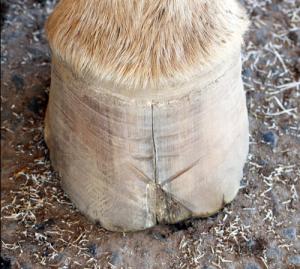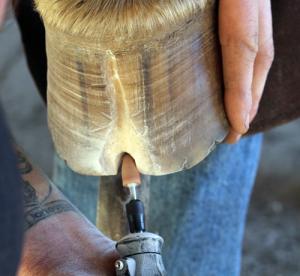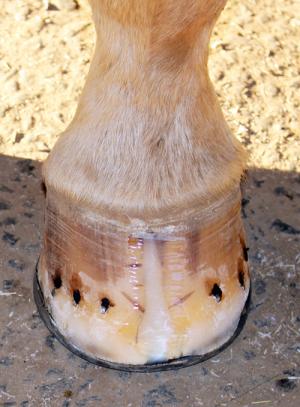There are many ways to treat hoof cracks that work, and many ways that do not. In this article we discuss the two most common ways to repair hoof cracks. One way works and the other does not.
The hoof in photo 1 has a toe crack. Upon arrival, someone had previously attempted to stop the crack by cutting grooves in the hoof with a rasp. This method does not work. Originally this crack was only as tall as where grooves where cut. But as you can see, the crack has split higher towards the hairline. The idea of cutting the X groove comes from trying to stop a crack in a windshield of a vehicle. In turn, the pressure from the crack has an area to disperse.
But applying the same method to a toe crack doesn’t work. What makes a toe crack split is the debris that packs into the crack, much like driving a wedge into a log. The farther the wedge is driven, the more the log splits. When a hoof crack fills with debris, dirt, manure, etc., it packs tighter and tighter with every step the horse takes, therefore, increasing the split/toe crack.
This method works!
One proper method of treating a hoof crack is to remove the affected hoof wall to thoroughly clean and then fill the area. By opening the crack, as shown in this photo, the farrier is able to remove any dirt and bacteria from the crack. Then the crack is filled with a special epoxy to replace the affected wall. By doing this, no more debris will pack into the crack. The epoxy has become part of the hoof and will grow out with the hoof with proper maintenance.
The finished result of repairing this hoof crack by the method described above is a much cleaner and healthier horse’s hoof.
It is very important to treat hoof cracks promptly and correctly to ensure a healthy sound horse.
Provided by Link Casey, Owner, Instructor, Casey & Son Horseshoeing School in Georgia.
Master Farrier, Master Educator, member of Farriers’ National Research Center, BWFA
Check out our websites at: www.caseyhorseshoeing.com
www.farriersnationalresearchcenter.com
Check out our Hoof Care Articles and YouTube videos – designed for the horse owner – to learn more about the importance of hoof care and regular maintenance by professional farriers.










